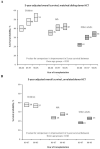Outcomes of allogeneic hematopoietic cell transplantation for adolescent and young adults compared with children and older adults with acute myeloid leukemia
- PMID: 22040843
- PMCID: PMC3288160
- DOI: 10.1016/j.bbmt.2011.10.031
Outcomes of allogeneic hematopoietic cell transplantation for adolescent and young adults compared with children and older adults with acute myeloid leukemia
Abstract
Adolescents and young adults (AYAs) with cancer have not experienced improvements in survival to the same extent as children and older adults. We compared outcomes among children (<15 years), AYAs (15-40 years) and older adults (>40 years) receiving allogeneic hematopoietic cell transplant (HCT) for acute myeloid leukemia (AML). Our cohort consisted of 900 children, 2,708 AYA, and 2,728 older adult recipients of HLA-identical sibling or unrelated donor (URD) transplantation using myeloablative or reduced-intensity/nonmyeloablative conditioning. Outcomes were assessed over three time periods (1980-1988, 1989-1997, 1998-2005) for siblings and two time periods (1989-1997, 1998-2005) for URD HCT. Analyses were stratified by donor type. Results showed overall survival for AYAs using either siblings or URD improved over time. Although children had better and older adults had worse survival compared with AYAs, improvements in survival for AYAs did not lag behind those for children and older adults. After sibling donor HCT, 5-year adjusted survival for the three time periods was 40%, 48%, and 53% for children, 35%, 41%, and 42% for AYAs, and 22%, 30%, and 34% for older adults. Among URD HCT recipients, 5-year adjusted survival for the two time periods was 38% and 37% for children, 24% and 28% for AYAs, and 19% and 23% for older adults. Improvements in survival occurred because of a reduction in risk of treatment-related mortality. The risk of relapse did not change over time. Improvements in survival among AYAs undergoing allogeneic HCT for AML have paralleled those among children and older adults.
Copyright © 2012 American Society for Blood and Marrow Transplantation. Published by Elsevier Inc. All rights reserved.
Figures
References
-
- Bleyer A. The adolescent and young adult gap in cancer care and outcome. Curr Probl Pediatr Adolesc Health Care. 2005;35:182–217. - PubMed
-
- Adolescent and Young Adult Oncology Progress Review Group . Closing the gap: Research and care imperatives for adolescents and young adults with cancer. Department of Health and Human Services, National Institutes of Health, National Cancer Institute, and the LiveStrong Young Adult Alliance; Bethesda, MD: 2006. NIH Publication No. 06-6067. http://planning.cancer.gov/library/AYAO_PRG_Report_2006_FINAL.pdf.
-
- Bleyer WA. Cancer in older adolescents and young adults: epidemiology, diagnosis, treatment, survival, and importance of clinical trials. Med Pediatr Oncol. 2002;38:1–10. - PubMed
-
- Zebrack B, Mathews-Bradshaw B, Siegel S. Quality cancer care for adolescents and young adults: a position statement. J Clin Oncol. 2010;28:4862–4867. - PubMed
-
- Albritton K, Bleyer WA. The management of cancer in the older adolescent. Eur J Cancer. 2003;39:2584–2599. - PubMed
Publication types
MeSH terms
Substances
Grants and funding
LinkOut - more resources
Full Text Sources
Medical
Research Materials


